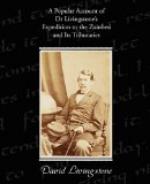and the wisdom of the wise has not been handed down.
They have had their minstrels too, but mere tradition
preserves not their effusions. One of these,
and apparently a genuine poet, attached himself to
our party for several days, and whenever we halted,
sang our praises to the villagers, in smooth and harmonious
numbers. It was a sort of blank verse, and each
line consisted of five syllables. The song was
short when it first began, but each day he picked
up more information about us, and added to the poem
until our praises became an ode of respectable length.
When distance from home compelled his return he expressed
his regret at leaving us, and was, of course, paid
for his useful and pleasant flatteries. Another,
though a less gifted son of song, belonged to the Batoka
of our own party. Every evening, while the others
were cooking, talking, or sleeping, he rehearsed his
songs, containing a history of everything he had seen
in the land of the white men, and on the way back.
In composing, extempore, any new piece, he was never
at a loss; for if the right word did not come he halted
not, but eked out the measure with a peculiar musical
sound meaning nothing at all. He accompanied
his recitations on the
sansa, an instrument
figured in the woodcut, the nine iron keys of which
are played with the thumbs, while the fingers pass
behind to hold it. The hollow end and ornaments
face the breast of the player. Persons of a
musical turn, if too poor to buy a sansa, may be seen
playing vigorously on an instrument made with a number
of thick corn-stalks sewn together, as a sansa frame,
and keys of split bamboo, which, though making but
little sound, seems to soothe the player himself.
When the instrument is played with a calabash as a
sounding board, it emits a greater volume of sound.
Pieces of shells and tin are added to make a jingling
accompaniment, and the calabash is also ornamented.
After we had passed up, a party of slaves, belonging
to the two native Portuguese who assassinated the
chief, Mpangwe, and took possession of his lands at
Zumbo, followed on our footsteps, and representing
themselves to be our “children,” bought
great quantities of ivory from the Bawe, for a few
coarse beads a tusk. They also purchased ten
large new canoes to carry it, at the rate of six strings
of red or white beads, or two fathoms of grey calico,
for each canoe, and, at the same cheap rate, a number
of good-looking girls.
CHAPTER VII.
The Victoria Falls of the Zambesi—Marvellous
grandeur of the Cataracts—The Makololo’s
town—The Chief Sekeletu.
During the time we remained at Motunta a splendid
meteor was observed to lighten the whole heavens.
The observer’s back was turned to it, but on
looking round the streak of light was seen to remain
on its path some seconds. This streak is usually
explained to be only the continuance of the impression
made by the shining body on the retina. This
cannot be, as in this case the meteor was not actually
seen and yet the streak was clearly perceived.
The rays of planets and stars also require another
explanation than that usually given.




